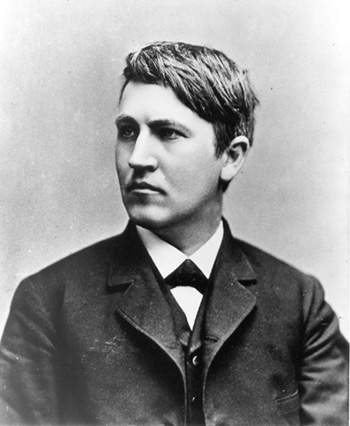1968, Thomas Edison starts working for the
Western Union office in Boston as a telegraph operator. Also in this
year Edison filed for his first patent for an automatic
vote recorder which he had intended to be used by the legislature. The
patent was excepted the next year. The next patent that Edison applied
for was also in 1869 for an improved stock ticker which he had been
working on. After these two inventions Edison was compelled to devote
all of his time to inventing. So he quit his job in order to spend all
of his time working on research and inventing.
Edison moved to New York in order to persue his dream. However, lack of money drove him to find friends to borrow from in New York. But by a stroke of luck he landed a very high paying job working for Law's Gold Indicator Company. The following month he was promoted. Shortly later Edison applied for another patent on an improvement of his printing telegraph.



Previous Home Next
Edison moved to New York in order to persue his dream. However, lack of money drove him to find friends to borrow from in New York. But by a stroke of luck he landed a very high paying job working for Law's Gold Indicator Company. The following month he was promoted. Shortly later Edison applied for another patent on an improvement of his printing telegraph.
Telegraph Machine


Backed by Law's Gold
Indicator Company and Western Union Edison opened a shop in Jersey
City. Edison worked on many forms of advancement for telegraphy. Edison
realized the true power of the companies backing him when Western Union
just bought out a competitor who was out selling them for a variation
of the printing telegraph. By the summer of 1870 Edison had taken out
seven patents relative to telegraphic communication. Then Edison was
asked to join the technical staff and improve on Callahan's stock
printer. Of course, Edison agreed. Weeks later Edison demonstrated a
device to the bored of directors, a new ticker which worked far better.
Edison was paid $40,000 for the invention.
On his own, in 1871 Edison started full scale production of stock tickers. He even employed 150 men to make a large order recieved from Western Union. Then He opened a small third party factory with George Harrington, making the Edison & Harrison firm. This new partnership aid at manufacturing automatic printing telegraphs. Some of Edison's current side tracks include perfecting the phonograph and improving the telephone.
On his own, in 1871 Edison started full scale production of stock tickers. He even employed 150 men to make a large order recieved from Western Union. Then He opened a small third party factory with George Harrington, making the Edison & Harrison firm. This new partnership aid at manufacturing automatic printing telegraphs. Some of Edison's current side tracks include perfecting the phonograph and improving the telephone.



Previous Home Next
